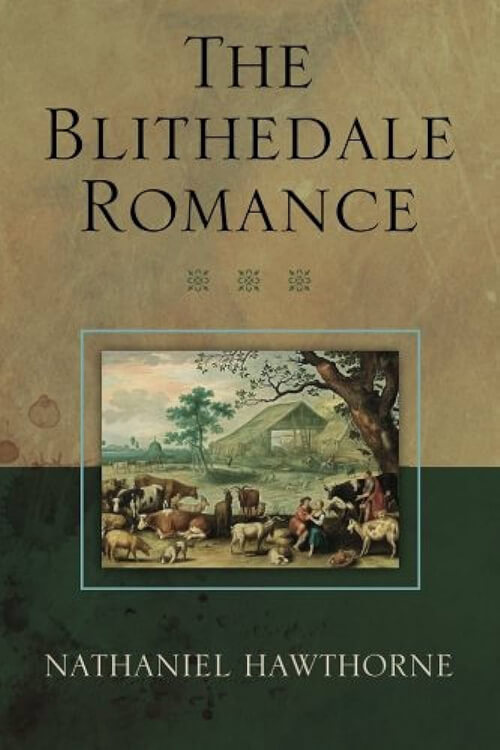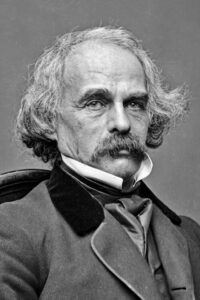
The Blithedale Romance
The evening before I departed for Blithedale, I was returning to my bachelor apartments, after attending the wonderful exhibition of the Veiled Lady, when an elderly man of rather shabby appearance met me in an obscure part of the street.
“Mr. Coverdale,” said he softly, “can I speak with you a moment?”
As I have casually alluded to the Veiled Lady, it may not be amiss to mention, for the benefit of such of my readers as are unacquainted with her now-forgotten celebrity, that she was a phenomenon in the mesmeric line; one of the earliest that had indicated the birth of a new science, or the revival of an old humbug. Since those times her sisterhood has grown too numerous to attract much individual notice; nor has any one of them come before the public under such skilfully contrived circumstances of stage effect as those which at once mystified and illuminated the remarkable performances of the lady in question. Nowadays, in the management of his “subject,” “clairvoyant,” or “medium,” the exhibitor affects the simplicity and openness of scientific experiment; and even if he professs to tread a step or two across the boundaries of the spiritual world, yet carries with him the laws of our actual life and extends them over his preternatural conquests. Twelve or fifteen years ago, on the contrary, all the arts of mysterious arrangement, of picturesque disposition, and artistically contrasted light and shade, were made available, to set the apparent miracle in the strongest attitude of opposition to ordinary facts. In the case of the Veiled Lady, moreover, the interest of the spectator was further wrought up by the enigma of her identity, and an absurd rumor (probably set afloat by the exhibitor, and at one time very prevalent) that a beautiful young lady, of family and fortune, was enshrouded within the misty drapery of the veil. It was white, with somewhat of a subdued silver sheen, like the sunny side of a cloud; and, falling over the wearer from head to foot, was supposed to insulate her from the material world, from time and space, and to endow her with many of the privileges of a disembodied spirit.
Read or download Book
Nathaniel Hawthorne
Nathaniel Hawthorne (born Nathaniel Hathorne; July 4, 1804 – May 19, 1864) was an American novelist and short story writer. His works often focus on history, morality, and religion.
He was born in 1804 in Salem, Massachusetts, to a family long associated with that town. Hawthorne entered Bowdoin College in 1821, was elected to Phi Beta Kappa in 1824, and graduated in 1825. He published his first work in 1828, the novel Fanshawe; he later tried to suppress it, feeling that it was not equal to the standard of his later work. He published several short stories in periodicals, which he collected in 1837 as Twice-Told Tales. The following year, he became engaged to Sophia Peabody. He worked at the Boston Custom House and joined Brook Farm, a transcendentalist community, before marrying Peabody in 1842. The couple moved to The Old Manse in Concord, Massachusetts, later moving to Salem, the Berkshires, and then to The Wayside in Concord. The Scarlet Letter was published in 1850, followed by a succession of other novels. A political appointment as consul took Hawthorne and their family to Europe before their return to Concord in 1860. Hawthorne died on May 19, 1864.
Much of Hawthorne’s writing centers on New England, many works featuring moral metaphors with an anti-Puritan inspiration. His fiction works are considered part of the Romantic movement and, more specifically, dark romanticism. His themes often center on the inherent evil and sin of humanity, and his works often have moral messages and deep psychological complexity. His published works include novels, short stories, and a biography of his college friend Franklin Pierce, written for his 1852 campaign for President of the United States, which Pierce won, becoming the 14th president.
Biography
Early life
Nathaniel Hathorne, as his name was originally spelled, was born on July 4, 1804, in Salem, Massachusetts; his birthplace is preserved and open to the public. His great-great-great-grandfather, William Hathorne, was a Puritan and the first of the family to emigrate from England. He settled in Dorchester, Massachusetts, before moving to Salem. There he became an important member of the Massachusetts Bay Colony and held many political positions, including magistrate and judge, becoming infamous for his harsh sentencing. William’s son, Hawthorne’s great-great-grandfather, John Hathorne was one of the judges who oversaw the Salem witch trials. Hawthorne probably added the “w” to his surname in his early twenties, shortly after graduating from college, to dissociate himself from his notorious forebears. Hawthorne’s father Nathaniel Hathorne Sr. was a sea captain who died in 1808 of yellow fever in Dutch Suriname; he had been a member of the East India Marine Society. After his death, his widow moved with young Nathaniel, his older sister Elizabeth, and their younger sister Louisa to live with relatives named the Mannings in Salem, where they lived for 10 years. Young Hawthorne was hit on the leg while playing “bat and ball” on November 10, 1813, and he became lame and bedridden for a year, though several physicians could find nothing wrong with him.
In the summer of 1816, the family lived as boarders with farmers before moving to a home recently built specifically for them by Hawthorne’s uncles Richard and Robert Manning in Raymond, Maine, near Sebago Lake. Years later, Hawthorne looked back at his time in Maine fondly: “Those were delightful days, for that part of the country was wild then, with only scattered clearings, and nine-tenths of it primeval woods.” In 1819, he was sent back to Salem for school and soon complained of homesickness and being too far from his mother and sisters. He distributed seven issues of The Spectator to his family in August and September 1820 for fun. The homemade newspaper was written by hand and included essays, poems, and news featuring the young author’s adolescent humor.
Hawthorne’s uncle Robert Manning insisted that the boy attend college, despite Hawthorne’s protests. With the financial support of his uncle, Hawthorne was sent to Bowdoin College in 1821, partly because of family connections in the area, and also because of its relatively inexpensive tuition rate. Hawthorne met future president Franklin Pierce on the way to Bowdoin, at the stage stop in Portland, and the two became fast friends. Once at the school, he also met future poet Henry Wadsworth Longfellow, future congressman Jonathan Cilley, and future naval reformer Horatio Bridge.






